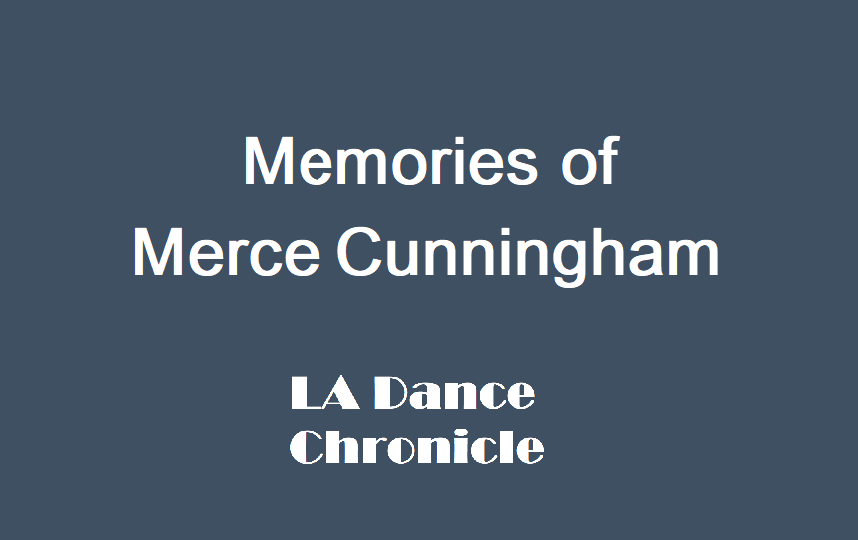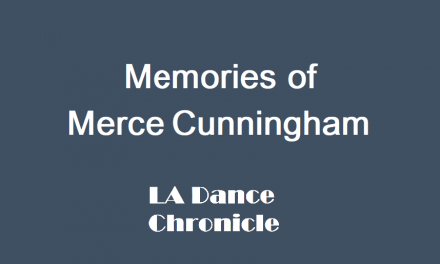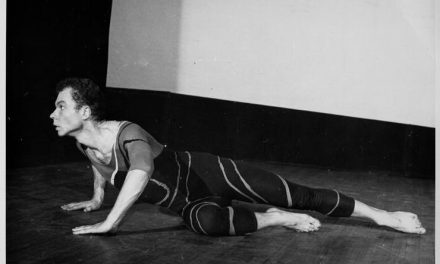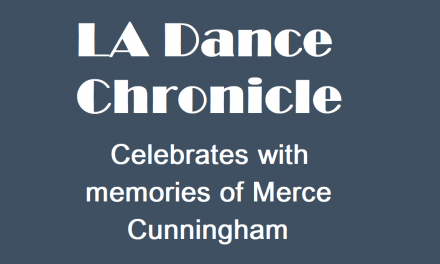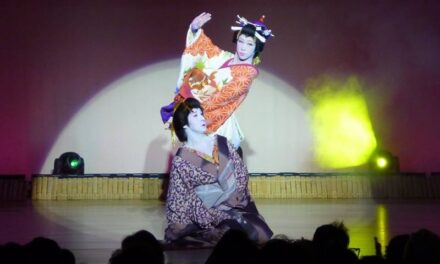Before I saw Merce Cunningham’s work on his own company, it was American Ballet Theater that brought Cunningham’s Duets to L.A. on tour in the 1990s. The skittle-colored unitards a far cry from Swan Lake tutus, the seemingly haphazard John Cage score (which I now know was appropriately named Improvisation III), and those hyper-trained ballet dancers trying to simultaneously be pulled up in pointe shoes while grounded in the movement. It all made an indelible memory.
Later, when I saw the Cunningham company performing Duets, on television as I recall, the dancing made a different kind of sense. While the ABT dancers conveyed a remoteness, not robotic, but a seriousness devoid of emotion, the Cunningham dancers, while certainly not exuberantly emotional, radiated a humanity, missing from the ABT version. Perhaps it was having been immersed in Cunningham’s technique or perhaps getting to dance barefoot. Both had value and helped educate me on how ballet could reinterpret what originally was created as modern dance and how bi-lingual dance can be.
-Ann Haskins
When Merce was traveling in LA with his company, in 2000, I attended an informal public conversation with him. I remember the year, because I was pregnant with our twins, who are now 18. I asked Merce, what advice do you have for a soon-to-be parent? Merce said, try to have your children get to know real things first, before they encounter representations of things. Of course, I never forgot that suggestion, but that was because in large measure I realized how nearly impossible that was: A tree before a picture of a tree. Check. Water before a picture of water. Check. A bear before a stuffed teddy. Uncheck. A duck before a rubber ducky. Uncheck. The list goes on. I am thankful for Merce’s reminder that it is the experience of the the world we are in, rather than the world we have made that stirs us most.
-Victoria Marks
Merce was always an inspiration, although I wasn’t at my best doing all that counting, he certainly helped me to raise my own bar.
In the 1970’s I was invited to appear on The Today Show along with Twyla Tharp to help promote Don McDonagh’s book, The Rise and Fall and Rise of Modern Dance. I was allowed one minute and 40 seconds. And I was delirious because I wanted to do part of Coverage. Bumping into Merce at Westbeth he suggested I do one second from each section. Again he provided a challenge that influenced my work.
Upon sharing with him that I was coming out to Los Angeles, he wasn’t too encouraging. That could have been for more than professional reasons. And then I met Jeff Slayton, and rest is history. Thanks for pushing me Jeff.
-Rudy Perez
My memory of Merce Cunningham goes back to the time when my sister, Viola Farber, was a student at Black Mountain College. Although I always lived far from Viola, I often heard from her about Merce. And then the time came when she was a member of his company! Then, of course, I received frequent reports, including information about tours on which the company went. This modern approach to dance was completely new to me, as a student of physics, and I would never have come in contact with it except for this connection—and what I would have missed!
Regrettably, I attended only one or two actual performances of the Cunningham Company, when tours included visits to Chicago, my residence. Especially through the connection with my sister, I was immensely impressed with the utter skill and beauty, and inventiveness and originality, of the performances. And my sister was a part of them! Her experience with Merce was so valuable that she later was able to form her own company. I think Chicago, too, will have events this year commemorating Merce Cunningham.
-Elisabeth Lanzl
I think I first saw Merce Cunningham Company when I was 13 at the Music Center in Boston. Merce did a solo. My only memories of that concert are 1) how could they let anyone so old go onstage? of course if I was 13 he would only have been about 53(!) and 2)I was outraged at the volume of the music which was extremely painful. I couldn’t understand how it was allowed to do something so harmful.
That next summer was my first enrollment at The Jacob’s Pillow School where I had Cunningham, which was my first real contact with a Modern technique. My teacher was Albert Reid. I remember Albert in great detail, his quiet nature, he had a foot injury, and did exercises for it. I remember how curious about him I was, and how hard it was to engage him. I remember zero about the technique except for the droopy hand thing with arms in second that all the Cunningham people seemed to have. I think they were copying Merce. Anyway it didn’t stick. I went on a couple decades later to get deeply into Graham and Horton.
Later I started to view Cunningham performances with great interest, and started to see his designs as something important. Even later, after studying with Jeff Slayton and performing some of his choreography, I started absorbing some of the Cunningham elements into my own technique class which had become a kind of hybrid fusion of classical modern styles which I think Cunningham technique could be called now.
I only came face to face with Merce once – it was back stage at the Dorothy Chandler which could have been around 2004 – I was with Rudy Perez. I remember being stunned at seeing Merce while in a wheelchair taking so much concern over Rudy’s well being. “But Rudy how are you? Are you alright?” He kept repeating. I cried afterward.
-Sarah Swenson
After graduating from Bennington College, I studied with Merce in the 60’s at his New York studio, taking both his advanced/co classes and a choreography class he taught with Buckminster Fuller sometimes there with him. Sometimes John Cage was there. Cage and Copland had been 2 of my favorite composers when in high school, and I used a piece of his for my first dance effort while at Bennington.
Merce had extremely high standards, and I loved the classes. Technique classes were also sometimes also taught by Carolyn Brown, Viola Farber, and Gus Solomons. In the choreography class we were a diverse group, including Meredith Monk, Elaine Summers (I think), Becky (can’t remember last name) and some more traditional who choreographed for more traditional dance and opera companies. Some of the elements we worked with were experimenting with doing some of the moves in the wings, and how it affected what you would later see as it moved onto the main stage, and what you might give your audience to alter how they would see you. I brought in bottle bottoms and glass to look through. Some of it had to do with using different methods (dice, I Ching) to plan the order of pieces in a dance, including directions traveling, tempos, which upper body went with the bottom, etc. Because so many of the others in the class would show traditional (modern) movement phrases, I would sometimes show phrases of Isadora Duncan fragments, as I had performed some of her work when in Guatemala with Vol Quitzow. (His parents had the “Temple of the Wings” in Berkeley or Oakland CA and taught Duncan. They also housed Jose Limon when he first came to the United States). That kind of movement always seemed to startle Merce- it was so different from his linear pureness. He was just starting to tour more. I also went to see his concerts. About half of the audience usually walked out as they didn’t like the music. Many years later, the same thing happened when he performed at UCLA here in California. It takes a while to train audiences sometimes.
David Vaughan was always at the entrance desk for years. After I began doing Broadway shows and touring, I stopped his classes, as I never felt as strong technically as when I was first a student there. And he was not teaching as much, a big draw. But I sometimes use some of his devices in structuring dances and usually start somewhere in the middle of a new piece until I discover what it is about.
-Louise Reichlin – Founding Director Louise Reichlin & Dancers/Los Angeles Choreographers & Dancers – louisehr@LAChoreographersAndDancers.org
Although I never met him or studied with him, he changed the way I view dance and danced in a most fundamental way. Definitely for the better. His artistry, philosophy, and sensibilities have enriched my dancing life and teaching. Gloria Newman was a huge fan! We had such great times talking about him and watching the company. My admiration is deep, as is my jealousy of you having worked so intimately with him.
-Gladys Kares
[Rudy Perez forwarded this thought from Phyllis Lamhut]
Always interesting Rudy. I studied with him from 1961-71. I used to stand behind Carolyn Brown in class. She never made a mistake…
-Phyllis Lamhut

